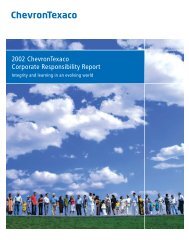Download PDF - Chevron
Download PDF - Chevron
Download PDF - Chevron
Create successful ePaper yourself
Turn your PDF publications into a flip-book with our unique Google optimized e-Paper software.
UPSTREAM<br />
>><br />
United States<br />
<strong>Chevron</strong>Texaco was the third-largest hydrocarbon<br />
producer in the United States in 2004, with daily net<br />
production of more than 500,000 barrels of crude oil<br />
and natural gas liquids and nearly 1.9 billion cubic<br />
feet of natural gas. On an oil-equivalent basis, these<br />
volumes represented about one-third of the company’s<br />
worldwide production for the year. The U.S. portfolio is<br />
anchored by mature assets concentrated in the Gulf of<br />
Mexico, California, Louisiana, Texas, New Mexico and<br />
the Rocky Mountains.<br />
During 2004 the company sold approximately 300<br />
properties which, along with assets sold in late 2003,<br />
accounted for about 30,000 barrels of oil-equivalent<br />
production per day, or less than 5 percent of the average<br />
daily production for the year in the United States. These<br />
properties were no longer considered strategic to the<br />
upstream asset portfolio. Certain other properties, representing<br />
less than one percent of daily U.S. production,<br />
are earmarked for sale in 2005.<br />
In September 2004, Hurricane Ivan hit the Gulf of<br />
Mexico region, causing significant damage to production<br />
facilities and pipelines. The damages lowered 2004<br />
average daily net oil-equivalent production by 21,000<br />
barrels. Before the hurricane struck, the company evacuated<br />
and later remobilized more than 1,600 workers in<br />
the Gulf of Mexico without a safety incident.<br />
U.S. Upstream received a number of health, environment<br />
and safety awards during 2004, including the<br />
Bureau of Land Management Oil and Gas Operator of<br />
the Year Award in the San Joaquin Valley; the California<br />
Department of Oil and Gas Clean Lease Award; the<br />
New Mexico Energy, Minerals and Natural Resources<br />
Department Oil Conservation Division Environmental<br />
Merit Award; recertification for the Wyoming Workers<br />
Safety Voluntary Protection Program OSHA Star Award<br />
at the Whitney Canyon/Carter Creek facility; a Minerals<br />
Management Service (MMS) Safety Award for Excellence<br />
(SAFE) for Gulf of Mexico, New Orleans district and<br />
an MMS SAFE for the Gulf of Mexico, Houma district;<br />
several MMS corporate leadership awards; and a nomination<br />
for the MMS 2004 National SAFE.<br />
CALIFORNIA<br />
Operating primarily in the San Joaquin Valley,<br />
<strong>Chevron</strong>Texaco again ranked No. 1 in oil-equivalent<br />
production in California in 2004, with average net daily<br />
production of 217,000 barrels of crude oil, 108 million<br />
cubic feet of natural gas and 4,000 barrels of natural<br />
gas liquids. With 84 percent of the crude oil production<br />
considered heavy oil (API gravity of 22° or below), heat<br />
management continues to be a major operational focus<br />
in the recovery of these reserves.<br />
The three major San Joaquin Valley crude oil<br />
fields – Kern River, Midway Sunset and Cymric – had<br />
combined net oil-equivalent production of 170,000 barrels<br />
per day in 2004. The Kern River Field is a mature<br />
steamflood operation with net oil-equivalent production<br />
exceeding 95,000 barrels per day during the year.<br />
Activity at Kern River focused primarily on an accelerated<br />
drilling program for 200 infill wells. An infill program<br />
with another 100 wells is planned for 2005.<br />
<br />
<br />
<br />
<br />
<br />
<br />
<br />
<br />
<br />
<br />
<br />
<br />
<br />
<br />
<br />
<br />
<br />
<br />
<br />
<br />
Diatomite Reservoirs<br />
<strong>Chevron</strong>Texaco has crude oil resources in diatomite<br />
reservoirs at Lost Hills, Cymric, McKittrick and Midway<br />
Sunset fields. Formed from the skeletons of countless<br />
prehistoric microorganisms called diatoms, diatomite is<br />
a reservoir rock with very high porosity and low permeability<br />
that can be difficult to produce.<br />
In the central waterflood area of the Lost Hills Field<br />
(a light oil field), the company drilled 19 production<br />
wells and 69 injection wells during 2004 and increased<br />
water injection rates from 88,000 to 134,000 barrels a<br />
day. Combined with additional workover and stimulation<br />
jobs in the second half 2004, production at Lost<br />
Hills increased about 5 percent in 2004. At the north Lost<br />
Hills waterflood project, the company drilled 105 injection<br />
wells and 36 producing wells during 2004. Plans for<br />
2005 include 90 injection wells and 78 producing wells.<br />
Waterflood technology is being employed in the region<br />
to improve recovery of the field’s hydrocarbons. Net oilequivalent<br />
production for 2004 in the Lost Hills area<br />
averaged 20,000 barrels per day, an increase of 9 percent<br />
from 2003 levels.<br />
The company also has diatomite reservoirs containing<br />
heavy crude oil. Producing hydrocarbons from this<br />
type of formation presents unique technical challenges.<br />
At Cymric Field, a recovery technique utilizing a highpressure<br />
cyclic steaming process has been employed with<br />
demonstrated significant results. The 1Y Antelope project<br />
14

















